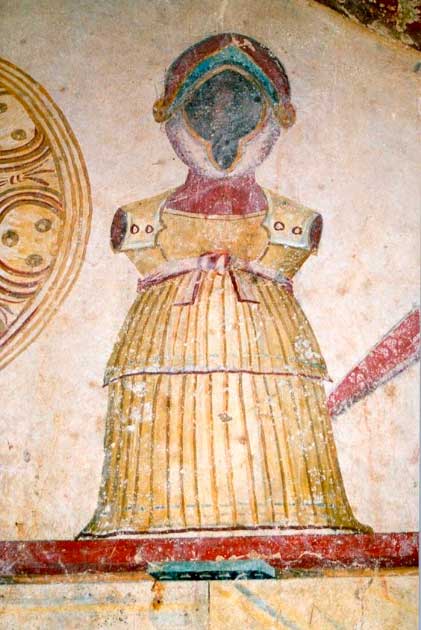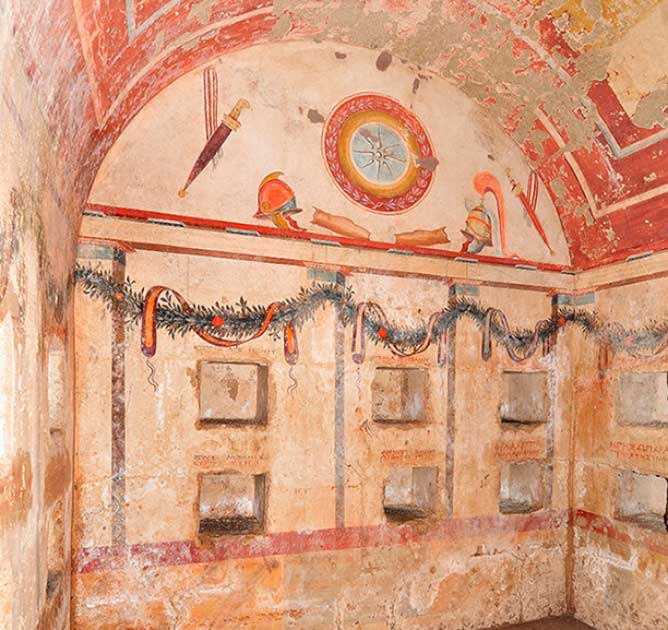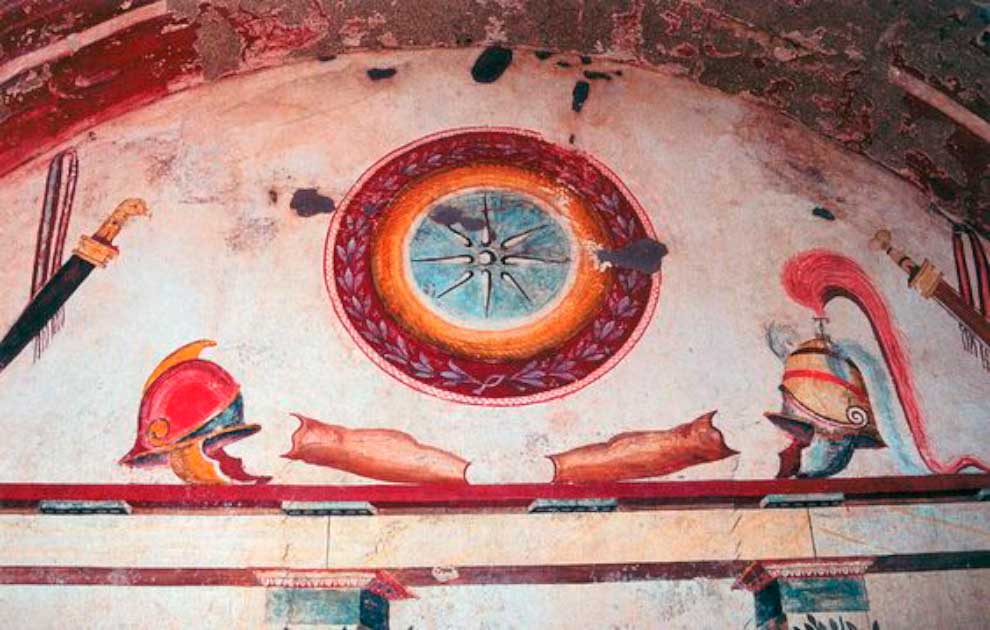The Tomb of Lyson and Kallikles: A Roman-style Macedonian Grave?
The Tomb of Lyson and Kallikles is the smallest of the four Macedonian Tombs of Lefkadia and holds a mystery that has become the subject of debate amongst scholars of art and architectural history. Located along the ancient road that led from Mieza to the Macedonian capital, Pella, the Tomb of Lyson and Kallikles houses the earliest example of what has come to be known as the Roman second style of painting (also known as Second Pompeian Style), a technique of enlarging a space through illusionary windows, columns, and realistic depictions of everyday items.
Archaeologists have used items discovered within the tomb to date its origin to the mid-Hellenistic period (the period between 323 BC and 31 BC). The Roman Second Style, however, dates from 60 BC to 20 BC.
Did the Tomb of Lyson and Kallikles inspire the Romans decades, even centuries later, or was this Macedonian Tomb simply a one-off example of experimentation, unknown until its discovery millennia later?
The Tomb of Lyson and Kallikles: First Studied in the 1970s
This Macedonian tomb was discovered in 1942 by archaeologist Charalambos I. Makaronas near the village of Leukadia. Little was made of the discovery at the time, despite the exceptionally well-preserved and ornately decorated interior.
- Tomb of Olympias, Alexander The Great’s Mother, Found!
- Does the Greatest Macedonian Rest In the Royal Necropolis at Aigai?
In the 1970s, an accomplished student of Macedonian architecture, Stella G. Miller, turned her attention to the tomb. After the death of Makaronas, Miller was forced to rely heavily on his field notes to complete what would otherwise have been a joint publication on the tomb. Sadly, the notes were incomplete and left many aspects of the discovery, from how it came about to what was originally discovered, a mystery. Still, Miller was able to compile a thorough study of the tomb and published it as a book: The Tomb of Lyson and Kallikles: A Painted Macedonian Tomb.
Who Were Lyson and Kallikles?
The tomb belonged to the family of a Macedonian man named Arisophanes, whose sons, Lyson, and Kallikles, were the first to be interred within its walls. Their brother Euippos constructed the tomb and inscribed their names on the lintel above the door. Little is known about the family, though paintings of swords and suits of armor on the walls suggest the family achieved military distinction during Macedonia’s struggle for dominance. Five generations of Aristophanes’ family are interred in the tomb, their names inscribed on seventeen of the twenty-two niches carved into the walls.

Painting of a cuirass (a piece of armor consisting of breastplate and backplate fastened together) on the front wall of the antechamber in the Tomb of Lyson and Kallikles. (Ancient painters of Macedonia / Public domain)
The Architecture of the Tomb of Lyson and Kallikles
The Tomb of Lyson and Kallikles is simple in its design. In typical Macedonian style, the tomb is a rectangular, subterranean structure with a vaulted roof.
The structure was covered by an earthen tumulus (burial mound) that was never removed, hence the excellent preservation of the interior. A dromos (passageway) leads to a double-door, over which is the inscribed lintel.
- Naples Necropolis Reveals Room-Like Tombs and Rare Greek Art
- Archaeologists May Have Identified 2nd Tomb at World-Famous Amphipolis Site
From there, a visitor enters a narrow, flat-surfaced antechamber decorated with colorful images of an altar with a snake crawling up the wall and a ceremonial basin. This corridor leads to the ornately decorated burial chamber. Twenty-two niches are carved into three of the four vibrantly painted walls to hold the ashes of the family.
The Splendor of the Burial Chamber
The burial chamber of the Tomb of Lyson and Kallikles is painted with a peristyle (columns enclosing a space) that seems to come out of the wall. Miller describes the effect as giving “the impression of being in a colonnaded courtyard with an indefinite space opening out beyond.” The effect was achieved via perspective lining and shading, as well as through implication.
For example, a garland painted along the walls seems to hang in free space between the pilasters (columns that are not freestanding, but are “submerged” into a structure), creating the illusion that it is floating in mid-air.
- Significant Ancient Tomb Guarded by Sphinxes Unearthed in Greece
- New Revelations Reignite Debate About Owner of the Lavish Amphipolis Tomb
Above the peristyle on the short sides of the chamber appears a shelf upon which the artist painted suits of armor abreast a large shield in the center. Swords appear on the far edges and seem to physically hang on sashes nailed to the wall.
The images are painted in vibrant reds, greens, and browns that stand out beautifully against the cream-colored walls. The effect is not only stunning, but entirely unique for its time.

A painting of armor and arms on the rear wall of the antechamber in the Tomb of Lyson and Kallikles. (Archaeological site of Mieza)
The Earliest Example of Asymmetrical Perspective
The effects described typify the Roman second style of wall painting, which was utilized to optically enlarge the small spaces within Roman homes. Realistic representations of everyday objects were employed against imagined backgrounds, such as gardens or walkways, to make cramped spaces feel more open. The technique is dated to around 60 BC in Rome.
The Tomb of Lyson and Kallikles clearly employs this same artistic style yet predates the Romans by decades at the very least. Miller notes that the Macedonians had eclectic tastes concerning art, and that this is exemplified in their tombs. She believes that the Tomb of Lyson and Kallikles was a natural evolution of experimentation with art and architecture but does not state whether there is a connection between this early example and the later style employed by the Romans. Others argue that the tomb is a one-off example of early illusionistic work with no connection to the fully-fledged style later prevalent in Rome.
Ultimately, the simple fact is that there is no way to state for certain what connection existed, if any. History is full of examples of ideas developing across vast distances, completely independently of one another. Despite the debate surrounding the possible connection between Macedonian and Roman art, scholars agree that the Tomb of Lyson and Kallikles is a historically significant discovery.
Its vibrantly decorated burial chamber is the earliest example of asymmetrical perspective, making it a valuable find worthy of study and discussion. Thankfully, the artwork inside the tomb is extremely well preserved and will remain that way. In 1999, a metal structure was erected over the site to ensure its protection from the elements, and the tomb is closed to visitors. Whether or not the tomb inspired the Romans, it will continue to inspire curious minds today and for generations to come.
Top image: The Macedonian Tomb of Lyson and Kallikles has long fascinated art scholars and more than a few see Roman stylistic influences in the ancient tomb. Source: Ancient painters of Macedonia / Public Domain
By Mark Johnston
References
Borza, E. 1995. Review of The Tomb of Lyson and Kallikles: A Painted Macedonian Tomb by Stella G. Miller. American Journal of Archeology, vol. 99, no. 1.
Hilton, J. 1995. Review of The Tomb of Lyson and Kallikles: A Painted Macedonian Tomb by S. G. Miller. The Classical Review, vol. 45, no. 1.
Makaronas, C.I. and Miller, S. G. 1974. The Tomb of Lyson and Kallikles: A Painted Macedonian Tomb. Archeology, vol. 27, no. 4.
Ninamil7. n.d. The Four Styles of Roman Wall Paintings. Available at: https://depts.washington.edu/hrome/Authors/ninamil7/TheFourStylesofRomanWallPaintings/pub_zbarticle_view_printable.html.
Psarra, I. n.d. Mieza, the macedonian Tomb of Lyson and Kallikles. Available at: http://odysseus.culture.gr/h/2/eh251.jsp?obj_id=879.

















